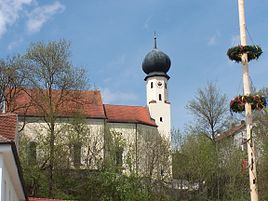Eitting (Laberweinting)
|
Eitting
Municipality Laberweinting
Coordinates: 48 ° 48 ′ 51 ″ N , 12 ° 19 ′ 43 ″ E
|
||
|---|---|---|
| Residents : | 133 (May 25 1987) | |
| Incorporation : | January 1, 1972 | |
|
Location of Eitting in Bavaria |
||
|
The branch church of St. John the Baptist
|
||
Eitting is a part of the municipality of Laberweinting in the Lower Bavarian district of Straubing-Bogen . Until 1972 it formed an independent municipality.
location
Eitting is located on the Kleine Laber about two kilometers northeast of Laberweinting.
history
The oldest evidence of Eitting's prehistory are Bronze Age barrows and ramparts. A statuette of the Roman trading god Mercury , which was discovered during excavations, refers to the later presence of the Romans . Outinga was first mentioned in a document in 901 . At that time Abbot Bishop Tuto von Regensburg exchanged two mills, two yokes of arable land, five yokes of meadows and twenty yokes of forest in Eitting. Eitting is a real -ing place and means "with Otto and his clan".
The bishops had a castle built on the Schlossberg, which was first mentioned in 1147. From the 13th century Eitting was a closed Hofmark with the Bishop of Regensburg as landlord and court lord. The castle was destroyed by the Swedes towards the end of the Thirty Years War in 1648 and left as a ruin. It was not rebuilt, and the castle chapel, which was still in use, was abandoned in 1683 due to its disrepair. Instead, the current church below the castle hill was consecrated in 1695.
On September 13, 1801, a picture of Maria Hilf was transferred to the church. The picture previously belonged to a merchant from Innsbruck , who had it painted for himself in 1779 and then gave it to his married daughter in Straubing . In 1800 the child of the Eittingen shoemaker Wolfgang Lindorfer, who was sick with the peeling, recovered after invoking Mary, whereupon the miraculous image was transferred to the church.
With the secularization in Bavaria in 1803, the entire episcopal property passed to the state. The castle ruins and fields were sold, and the forest and meadows as common land were divided among the Eittinger farm owners by lot. In 1912 a new village water supply was built with running water for the houses, and in 1914 electricity came to Eitting from the Gallhofen power station for the first time. In 1958 the energy company OBAG took over the power supply of the place. Land consolidation was carried out from 1955 to 1961, and in 1961 the first street lighting was installed in the town.
The municipality of Eitting belonged to the Mallersdorf district . As part of the regional reform in Bavaria , it was incorporated into the municipality of Laberweinting on January 1, 1972. At the end of 2011, Eitting had 115 inhabitants.
Attractions
- Filial church of St. John the Baptist. The early baroque complex above the Labertal was consecrated in 1695. The center of the high altar, which was created shortly thereafter, is an immaculate surrounded by angels. On the side altars are the figures of St. Erasmus and St. Ottilie, both from around 1500.
societies
- Farmers' Association Eitting
- Eitting volunteer fire brigade. It was founded in 1875.
- Eitting Hunting Association
- Volleyball club VC Eitting 09
- Stammtisch friends
- Edelweiss shooters
literature
- Susanne Hansen (ed.): The German places of pilgrimage , Pattloch Verlag, Augsburg, 2nd edition 1991, ISBN 3-629-00005-3
Web links
- Eitting website
- Eitting in the location database of the Bayerische Landesbibliothek Online . Bavarian State Library
Individual evidence
- ↑ Bavarian State Office for Statistics and Data Processing (Ed.): Official local directory for Bavaria, territorial status: May 25, 1987 . Issue 450 of the articles on Bavaria's statistics. Munich November 1991, DNB 94240937X , p. 236 ( digitized version ).


